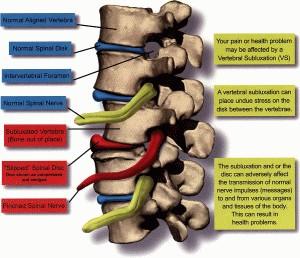Chiropractic Care for Back Pain
Generalized back pain is often caused by spinal subluxation and degenerative changes to the spine over time.
Subluxation
Subluxation is a term used in the chiropractic field to describe what happens when one of the vertebrae in your spine moves out of position. The word subluxation is derived from the Latin words meaning somewhat or slightly (sub) and to dislocate (luxate). When this happens, the misaligned vertebrae creates pressure and stress on the spinal nerves, blood vessels, and surrounding muscles. This pressure and stress can cause an imbalance in the body’s normal processes as the nerves in the spinal column extend to the entire body and its organs. As time goes on and the uncorrected subluxation settles, the damage to the nerve gets progressively worse and different stages of subluxation degeneration set in.
Subluxations can occur in a number of ways. A car accident, athletic injuries, birth trama, pregnancy, a fall, sudden jar, or other traumas are all examples of unique instances that may cause a subluxation. The other occurrence of subluxation comes from regular actions such as improper sleeping position, poor posture, or incorrect lifting processes.
Chiropractors are specialists in correcting subluxation and other misalignments. A chiropractor can restore the misaligned vertebrae to the proper position in the spinal column. They do this manually by using the chiropractic procedure known as a spinal adjustment. Your chiropractor, in most cases, will use his or her hands in applying corrective pressure to the spine in a specific direction and location. The manual force or thrust helps restore the alignment and mobility of the vertebrae. In some cases, the chiropractor may use instruments to detect a subluxation and adjust the spine. Under normal circumstances, chiropractic adjustments are painless. In cases of trauma, such as car accident, some discomfort may be experienced due to inflammation.

Degeneration
Your spine degenerates in stages or phases:
Degeneration Phase 1
First your spine loses its normal balance. There may be a loss of normal spinal curves. Your nerves may be affected and the vital life energy that flows over them is interfered with. Also your joints, discs, nerves and posture are stressed and age more quickly. Surprisingly, there may be no pain other than occasional minor discomfort. Also present may be a slight lessening of energy and slight height loss. Response to spinal care is generally good.
Degeneration Phase 2
Here there is a much greater degree of decay, disc narrowing and bone spurs (deformations); postural changes are much worse. This condition is very common (by age 40, 80% of males and 76% of females exhibit moderate disc degeneration). Spinal canal narrowing or stenosis may occur. This phase is characterized by more common aches and pains, fatigue, and a diminished ability to cope with stress. Height continues to decrease. With chiropractic care significant improvement is possible.
Degeneration Phase 3
Here there are more postural imbalances, increased nerve damage, permanent scar tissue and advanced bone deformation. Physical and/or mental weakness or disability begin. Also found in this phase are permanent loss of height and loss of energy. With care some reversal is possible.
Degeneration Phase 4
This is the most advanced stage of subluxation degeneration. The postural imbalance is severe and motion is limited. There is severe nerve damage, permanent scar tissue is formed and the bones may begin to fuse. In this phase we find pain, various degrees of physical or mental disability, and continued loss of energy and height. By now the condition is considered irreversible, although chiropractic may give some symptomatic relief.

HEALTH IS WEALTH
Ready to live a healthy, pain-free life without the use of drugs or surgery?

